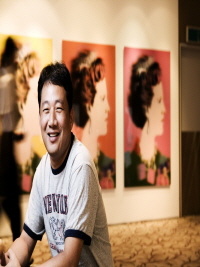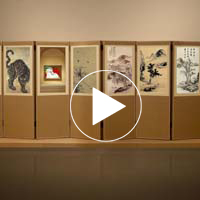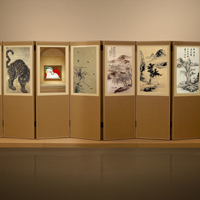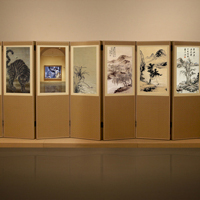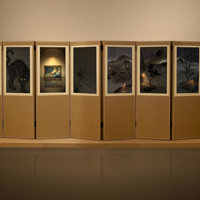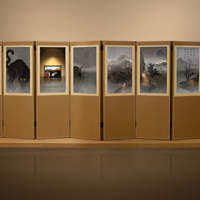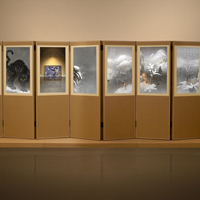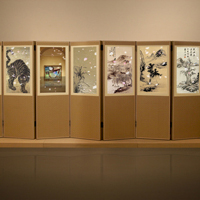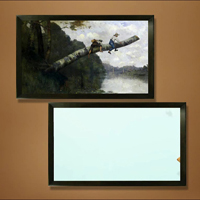Lee Lee-nam, An Endless Journey of Revived Tradition
1.
Passing through works indifferently, I stop before an Oriental painting it seems I have seen before. After a while butterflies and bees move, petals flutter in the wind, and fish romp. Seeing all this and after my exclamation of surprise - “Ah!” - the new character of the canvas bearing this Oriental painting emerges. The elements mentioned move in a flat monitor. This work’s title, size, and producer are visible at the bottom corner of the wall where this work is on display. Lee Lee-nam’s name and his works come into viewers’ sight for the first time.
2.
What first draws our eyes in his work is the conceptual metaphor ‘display and paper’, reminding us of a strong bond between flat panel display as electronic medium and paper as ground of painting. As this bond occurs to viewers’ mind immediately and unconsciously, people do not need to have any conscious thinking to understand this. Those who have seen his work once naturally accept the fact that the flat panel display plays the role of paper of classical Oriental painting. What they overlook is the fact that this idea never came up in their mind before Lee had concretized this conceptual metaphor.
What is perceived next is his work’s dynamic character. Pictures are usually painted on paper, remaining fixed and inseparable in its attributes. However, his work is reprocessed by a digital system. Due to the distinctive characteristic of digital medium in which information can be divided into a basic unit, discontinuity enables reproduction and modification through a process of readjustment. The still images of a bird are discontinuously arranged, but our sense of sight understands they have a dynamic attribute connecting frames. The connected frames enable the expression of diverse movements and insertion of information derived from a completely different context. With this feature of the medium the image of a plane flying across the center of an Oriental painting can be inserted, geometric lines crisscross, and figures and actions with a completely heterogeneous cultural context can be juxtaposed with Oriental images. Images may have cultural gaps, but information is homogeneous. The limit of expression a creator addressing digital visual media often faces due to this distinctive characteristic is in fact the limit of his imagination.
The digital and hybrid anchored to such a conceptual metaphor has a very close affinity. The digital is convenient in concretizing visual hybridity whereas the hybrid can be boundlessly expanded by the digital. What matters is elements that are hybridized. In other words, how can the classical Oriental painting tradition secure a position as a new artistic element in Lee Lee-nam’s work?
3.
With a panel display as paper, television as a frame, and moving image as a picture, there is a cognitive reason such related conceptual metaphors are easily accepted by the public. A moving image itself is a succession of still images. A picture is a halted image, and a video image is an accumulation of still images. With this strong affinity between moving and still images, people feel ease in recognizing the metaphor “A moving image is a picture.” This brings about two mutually different effects in Lee’s work. One is a strong universality. One who has a slight understanding of Oriental painting tradition can immediately grasp that Lee’s work is a modern representation of the tradition. The reason why Lee’s work is not difficult to understand unlike other avant-garde media art is due to the appropriation or hybridization of such familiar elements.
This hybrid lends two contrasting attributes to Lee’s work. The attributes appear when two Gestalt elements collide and coexist. The visual representation of Oriental painting invests his work with a sort of originality. As Oriental painting elements are appropriated in his work, his work implies the existence of the originals. Those viewing his work unconsciously conjecture that elements in the originals are also in Lee’s work. That is to say, appreciators feel they face a long-standing, authoritative cultural tradition familiar to them rather than something very old and authoritative while concentrating on the images. Anyone may feel the ancient tradition is represented with modern idioms in Lee’s work.
Despite his new work method, a key connotation within his work is unconsciously known to viewers. In this process the feature of his work’s medium vanishes into the background. We can perceive the feature of his medium, a flat panel display in his work, distanced from it. The image his work captures is outdated whereas the vessel containing it is up-to-date. Partly old and partly new, representation of old content through new form -------- The West calls this Renaissance while the East describes it as 溫故而知新, or Review the old and learn the new. Lee’s work is very old and simultaneously very new.
But that doesn’t mean his work is completely new, because there are rich, classical cases in this kind of hybrid. They include borrowed scenery in Oriental architecture and borrowed rhythm in Korean classic poetry. A more dramatic case is the appropriation of well-known verses as an analogy of Zen’s existentialism. In the case of borrowed scenery, extant landscape is transferred to the landscape to be seen and enjoyed through the frame of a window. In the case of borrowed rhythm borrowing specific parts of a poem and applying this to one’s own poem plays the dual function of enjoying the repetition of form and the difference of content. Zen masters often used famous verses of their age for describing a level of Zen. The following is part of a popular love poem quoted by Fayan.
I call “Xiao-yu! Xiao-yu!” with nothing to ask her. (頻呼小玉元無事)
I call her name just to enable my dear husband to hear my voice. (祗要檀郞認識聲)
The above verses sing of the bashful love of a wife who could not call her husband directly, instead calling her handmaid even though there was nothing to do. Her indirect speech - calling her handmaid instead of her husband - implies the literary originality here. Zen Buddhist priests regarded these verses as a depiction of Zen enlightenment. Although completely lured by this, practitioners do not know its name. Though they called a different name, even this is nothing but a means to reveal their affection for this. As the wife calling her maid waits for her husband’s response, Zen practitioners wait for the moment of enlightenment after completing their practices. Following the conceptual metaphor “Zen practice is love”, then “Enlightenment is one who loves and looks back on his or her lover.”
Borrowed scenery and borrowed rhythm; Zen Buddhist reinterpretation of a love poem, all are similar. Nature with an analog continuity is reinterpreted through the frame of a window, the same rhythm obtains a completely different context through different poetic emotion, and a love poem becomes a metaphor for the passivity of Zen enlightenment. An object universally has different meaning in a different context. Lee Lee-nam just concretizes this fact through the appropriation of Oriental painting tradition, adopting the medium of flat panel display.
4.
This feature of his work, however, works as a double-edged sword. As Lee’s hybrid is familiar, it is easy to understand and emulate. Oriental painting tradition itself offers abundant texts, but in the East there are numerous other traditions to be borrowed. Put briefly, how about the calligraphy tradition represented by Ouyang Xun, Yan Zhenqing, and Wang Xizhi? We know that calligraphy itself is one artistic genre in Oriental culture, and painting and calligraphy are closely bound up with each other.
We may envisage an artist who tries to depict Chusa Kim Jeong-hui’s Orchid (不作蘭) in the way similar to Lee Lee-nam. His work is akin to Lee in many respects. In his work however, many passages included in Chusa’s Orchid appear and disappear; background and character colors change. The orchid imagery sways as Lee’s does. How is his work different except for change in the characters of the phrases “In 20 years I haven’t depicted the orchid, I come to capture its true nature by chance.” (不作蘭花二十年 偶然寫出性中天)? However, the artist would say he took note of what Lee didn’t, asserting he has interpreted Eastern calligraphy tradition through his media art. In this regard, what right does Lee claim? Lee has paid almost no attention to change in such typography in his previous work. That is to say, we can say that Lee took little notice of the potential of calligraphy as significant object of visual imagery.
Numerous mandala images and hanging Buddhist painting images, and innumerable Taoist mythic images are also hybrid objects in work similar to that of Lee Lee-nam. Andy Warhol gave up his Pop Art conception to make cartoons after seeing Roy Lichtenstein’s work, and then he began piling up Brillo boxes. The difference between the cartoon and Brillo box gave rise to the gap between Warhol and Lichtenstein. The results caused by hybridity may be not so different to this. This has a risk of being deteriorated by the banal, but may be developed into a differentiated aspect. This does not matter for Pop artists who have accepted kitsch, but it would be matter for avant-garde artists, since something that can be called their identity may be in peril. This raises an underlying question to Lee Lee-nam: what type of artist does he want to become?
5.
There is another reason this question is raised. This is easily recognizable by considering the hallmarks of Lee’s medium. One of the mediums he addresses is flat panel display whose stereotyped name is television, one of the most common industrial products today. This means Lee’s work for conceptual integration has been developed along the two axes, television as mass media, and traditional Oriental painting. What’s matter here is television of mass media and the readymade, almost all families have. Addressing this medium, he meets a slightly strange situation. All families have television as a medium or paper. If so, where is the content of new art satisfying such televisions? This feature of pervasive canvases yet absent content reveals a keen conflict when it is fused into its commercial characters as a mass-produced item.
Although Lichtenstein adopted cheap cartoons as his subject matter, his work is never simple or easy, as Park Yeong-uk mentioned: “He sketches cartoon scenes, and transfers them onto the canvas after enlarging them with a projector. After, he completes the enlarged images with stencil, coloring, and outlines.” Put briefly, Lichtenstein took his subject matter from cartoons, but his work is far from mass production.
Lee’s work is akin to Lichtenstein in that it is made with a mixture of electrical work and manual work. What is decidedly different is his work is made not on canvas but on TV. This connotes such questions as “Does his work transform readymade into a work of art by making one sole television, or does he establish a universal art form applicable to all televisions?” If he concentrates on the former, his work would be avant-garde; if he is inclined to the latter, his work has a high probability of becoming the expansion of Warhol, who ran a factory. Pop artists still sway between dual identities, like artist and businessman, which also can be problematic in Lee’s work.
6.
At this point we can grasp from where the diversity of Lee’s exhibition derives. His conceptual integration neither interrupts the hybridity of flat panel display, Oriental painting tradition, nor encourages numerous types of hybrids transcending this. Friedrich Nietzsche expressed an insight similar to this as “The genius is a centaur, half beast, half man, and in addition, has angel’s wings upon his head.” By borrowing Nietzsche’s description, Lee Lee-nam combines the angel’s wings of the eminent Oriental painting tradition with the body of flat panel display. Nietzsche asks if another to be hybridized is left, suggesting that even the lower body of a four-leg animal has to be hybridized. There are actually numerous works showing that Lee tried to extend the scope of this hybrid. What we have to consider is why his art world clings so firmly to Oriental painting tradition without changing its outer appearance?
Something like an animal’s four legs depending on land, not the world of beauty like Oriental painting tradition, symbolized with ascending wings perhaps? Can he thus encompass the ugly, not the beautiful, as the object of his hybridization? If the ugly is not included in the list of his hybridity, we may ask why his work is ambiguously located on the borderline between modern and contemporary despite his medium’s newness and working method’s contemporary quality.
Going one step forward from here, what will happen? Imagining some predictable hybrid work, we can explore a new possibility. Oriental painting tradition consists of binominal opposition between the theory of copying form (形似論) and the theory of capturing the spirit of the subject (傳神論). For Xie He, who claimed the six principles of Chinese painting, the latter regards “Spirit resonance” (氣韻生動) or vitality, while the former “Correspondence to the object” (應物象形) or depicting of form. If Lee’s previous work makes an extreme assertion with one of them, what will happen? Lee’s work may proceed to the sublime, attaining the highest form or level of “Forgetting images when realizing meaning” (得意忘象). His work also may embody the lofty spirituality of Oriental painting with the breath of life (souffles vitaux) the French rediscovered, and Gilles Deleuze appropriated, (the concept here amazingly the translation of ‘qi’ in Spirit resonance), in which the lines of the universe rendered by brushstrokes intersect. This work will be similar to Zen masters’ enhancement of a love poem to a Zen metaphor. In other words, it is work seeking the level of TV-Zen, and the general public seem to understand Lee’s work as the embodiment of the sublime, unexpectedly.
Another way here is to carry-out hybridization beyond the border of the ugly represented by the lower half of the body of a four-legged animal. Of course, this attempt will include meta-critical work evolving contemporary art’s self criticism. Considering Artist’s Shit (Merda d’Artista) by Piero Manzoni, a scandalous artwork of 20th century art, the meaning of such a question is obvious. The work of art consisting of 90 tin cans containing the artist’s shit and labeled as such implies the spirit of thorough self criticism, stating that art is the shit of capitalism. Can we witness Lee’s work proceeding in this direction?
In Duchamp’s Room Lee showcases a model of Marcel Duchamp urinating into a urinal and a display included inside another urinal reproducing a urinating scene. Through this, Lee summons Marcel Duchamp and recalls George Orwell. Questioning the role of the dystopia Orwell imagined by relating his medium to Duchamp, Lee refers actually to Nam Jun Paik who explored the territory of another possibility the medium of video might have. This work is new in that it shows the movement to escape the artistic convention Lee has established. So, does Lee dream of an avant-garde artist critical of contemporary art’s meta-quality?
A final way is to make his work face social realities directly, for example, in pieces mentioning Gwangju Democratic Movement on May 18, or illustrating southern province landscapes. In this case a problem is how the feature of Lee’s previous works maintains a balance with his pieces conveying social messages. What we can say is Lee’s work has a new possibility at least in such three aspects. Some is already innate in his work, and others are mentioned through this exhibition. He raises a critical viewpoint to his previous work, and reveals his artistic sensibility measuring its limit and possibility.
The exhibition offers a farewell to the analog and introduces digital artistic experience. As such, the exhibition’s diversity encompasses our memories of analog experience and digital visual experience we will soon have. Displaying this is work that looks like a tower made up of cathode-ray tube televisions set, like Nam Jun Paik’s works, featuring a bird’s unrestricted movements projected onto a wall showing the experience of a screen-wall made possible by the expansion of a flexible flat panel display, and work exploring the possibility of a new visible experience through transparent display panels attachable to a car’s windows.
7.
In conclusion, the exhibition is penetrated by two huge axes. One is Lee’s exploration of visual experience his media can offer to viewers in the transitional period from the analog to the digital. The other is the show sends a signal indicating that Lee renews his work’s idioms, partly constricting the preexisting conventions he has established. Could he really go beyond his own limits? And so, could he attain new originality forming what the artist is? It is not easy, but he seems to announce he could do this. As a popular song recently in fashion predicts, “Time would be an answer to all.”
Hyang-Joon Lee(BK 21 Researcher, JeonNam University)
The Authenticity of Simulacrum- Discussion about Lee Nam Lee’s Art
Immanuel Kant argued that viewers and their view about art are contemplative. According to the argument, viewers develop critical mind about an art work while they are having a distance from the work with an objective attitude. However, media art provides viewers a chance to experience the art work closely. The media art is perceived in the process of building interrelationship between the viewers and the work. For the interrelationship, the viewers’ physical involvement is required with mental cognition and practical situation. The viewers can experience the art work as a part of reality from fulfillment of the requirements.
Lee Nam Lee’s art works do not ask viewers a physical involvement. His works, combination of borrowing images, is not far away from the contemplative attitude which mentioned above. However, Lee Nam Lee provides a structure of memories in his works. The essence of the art works appears from historical facts and reminiscent images. In Lee Nam Lee’s work, an image can not create an interspace because the image is not a process. Moreover, his art does not escape from the logic of text since the impression of image is powerful. As a result, a theme becomes an important subject to discuss for Lee Nam Lee’s work from a course of understanding. It means that knowing the metaphorical situation, which is composed of many images, in the work according to the theme is more important than realizing the stages of changes. The metaphorical situation appears on media art is not the first subject to be concerned because the situation has a characteristic of modernism. Lee Nam Lee’s images might be regarded having a formalist characteristic of modernism because the images resolve themselves into another visual scene. Nevertheless, he does not agree with the modernism’s resolution of experiences into art. Lee Nam Lee’s works would be defined as a parody of modernism in post-modernism context since a total destruction occurs from artificiality and juxtaposition.
Because a narrative in Lee Leenam’s work has an expansional characteristic from textural structure, its viewer can make an experience (traditional art) and participation (media art) in the work actively. Here, people should understand how to distinct new-media and multi-media. From technology side, new-media focuses on time in virtual reality. Multi-media tries to find a meaningful moment to define an art work’s characteristic when a combination of text, audio, video, and interactivity content forms. Multi media has a spatial aesthetic. From this aspect, involvement of viewers becomes an important factor to keep new-media and multi-media a part.
In 21st century, new media became a representative index for a new spirit of modern age. Understanding about functions of media in the tides of social and cultural changes is becoming a new way of communication in new media art era. For development of the new way of communication, a structure of narrative in texts changed to a structure of narrative in images. The process of changing was one-sided. Now, new media suggests emotional intercommunication. The intercommunication brings an active involvement of viewers. In Lee Nam Lee’s media art work, notion of space and time is open to virtual reality and the world of imagination builds up. Essential of his art works is openness from media (The openness can be periodical or aesthetical).
There is no need to choose superiority between the original works of Kang Heean and Jungsun and the works of Lee Nam Lee because the art works are a reinterpretation of the original works with a new technology. However, it is difficult to define that Lee Nam Lee’s video works show a progressive expansion in the field of reproduction although it can be stated as a possibility of reformation. Contrasting Lee Nam Lee’s works with a reproduction of film art or mentioning religious aspect appears on Lee Leenam’s work would dilute the essential of his works. Lee Nam Lee does not impose significance on time. This fact shows more features of a text than features of an image. To Lee Nam Lee, images approach as a narrative that composes a story. This is a reflection of his contemplative attitude toward examination of existence that was a popular theme in traditional art works. Scholars from Chosun period had a tendency to read a painting reasonably. They did not deal an artwork with an emotional sense. In the past, art was a way of communicating knowledge among nobles, not for the common people. Adding movement on a painting suggests a clue for interpreting the art work to people. As a result, Lee Nam Lee provides equality of opportunity and expands exclusive possession of art to folk art for the common people who live emotional and active lives.
According to an art historian Erwin Panofsky, film art is originally a product of genuine folk art. From the past, people have passion to give life to inanimate objects, and it can be achieved through film as a media. Lee Nam Lee’s art work reflects the passion on existed images. The art works give viewers a chance to penetrate into art which based on reason and knowledge as an exclusive possession of nobles. Sensibility was not an aesthetic element to interpret an art work. Application of sensibility also did not have an importance to see an art work from philosophical view in the past. However, movement suggests viewers experience something new with a response. The process of making a movement has a relationship with aesthetic attitude of media art because making a movement is imitating an activity in life. The process of copying alive physical activity provides viewers liberty. Moreover, the movement functions as spiritual and physical equipment to eliminate the distance between art and art viewers. Art is not an object to be in awe. Art shares intimacy of life with people. In 21st century, art escapes from exclusive authority of traditional art medium such as painting and sculpture. Art becomes a set of images with symbolic meanings as a means of communication for understanding of situations in reality. Recent years, dismysticism stands out from accommodation of art. Art is not a matter of belief but life. Media art is an important element for achieving the aim of 21st century art in dismysticism context.
Lee Nam Lee’s work has characteristics of modernism with the exception of appropriation and movement. Here, differences between traditional art and recent art about medium and logic are not concerned. The characteristics of modernism appear from the artist’s attitude toward art that brings a question on an aesthetic aspect. People have to be curious to know the differences between an original work and a reproduction developed from the original work. Original works of Lee Nam Lee is well known as master pieces of art. Lee Nam Lee used digital technology to give a movement on the original works. This process of art making is different from the traditional art making course. However, there are more factors to be concerned for acknowledgment of the differences because questions rise from being a witness to media art. In the strict sense, people can doubt whether reproduction creates a fake world or not. People also can despise reproduction as a new way of observation on a situation among many others. However, the results of origin and reproduction should not be regarded as having the same source.
As mentioned above, two questions rise from viewers of Lee Nam Lee’s media art work. Questioning about ‘appropriation’ itself is the first question. People have uncertainty about appropriation because they think appropriation can build a fake world. Appropriation is a reaction toward mind of postmodernism. The reaction can expand borrowing as an issue of a period when a social structural factor has a relation with art. If Lee Nam Lee’s work has a relationship with a response of media about mind situation in 21st century, people have to admire that the essential role of media lies on spiritual and inner sides of people. As a result, the rise of aesthetic questions from Lee Leenam’s work can be a philosophical examination, not an achievement of media art.
The second question is about the importance of appropriation. People can claim that appropriation is just one of new ways of observing a situation. For this claim, essentiality of borrowing and parody has to be studied seriously. Appropriation is not only bringing a form but also keeping the spirit of an original work in a different time and circumstance. The maintenance of spirituality dismantles external substances of the form. Parody emphasizes on value of spirituality in life. The situation, which the reality of sensibility exists in, goes beyond authenticity of a fact. A narrative with the spirituality in an art work refers to truth of meanings, not a fact.
Building an artistic boundary between an original and appropriational reproduction is going to be charge of next generation since the media art is on the start line of its beginning. “The simulacrum is never that which conceals the truth?it is the truth which conceals that there is none. The simulacrum is true.” In a French philosopher Jean Baudrillard’s philosophical treatise, he discusses the interaction between reality, symbols and society. In modern period, distinction between image and reality break down due to the proliferation of mass-produced copies. The item’s ability to imitate reality threatens to replace the original version. The simulacrum precedes the original and the distinction between reality and representation breaks down. There is only the simulacrum. Sensibility is a substitutional name of existence. The existence regards a situation in a virtual reality as an index to life. The situation is more significant in life than a momentary identity. Jean Baudrillard’s argument supports Lee Nam Lee’s art world. Object is no longer the center in the otology of art. Acknowledging the present situation of object cannot be overemphasized. Although some people might understand the context under Clement Greenberg’s theory, it is different. Clement Greenberg used the abstract expressionist movement to overcome the limitation of art on flat surface, such as a painting. To Greenberg, it was the physicality of the paintings’ clotted and oil-caked surfaced that was the key to understanding them as documents of the artists’ existential struggle. In media art, there is no limitation because broad possibilities are offered in its medium. Existence of sensibility, which has been disregarded in philosophical and aesthetic understanding about art in the past, becomes a real substance in media art. Lee Nam Lee’s art works proves the capacity of sensibility by showing development of an artistic situation. Moreover, Lee Nam Lee represents attributes of art in the era of simulacrum as a frontier.
Yongdo JUNG(Art Critic)






